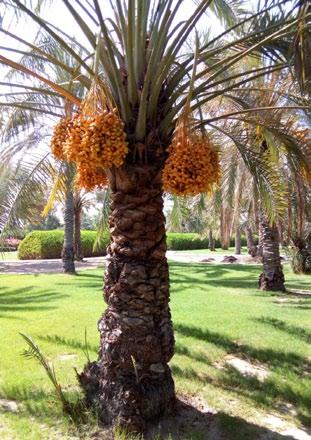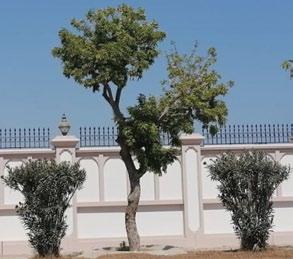
9 minute read
Bahrain streets set to be beautified
By John A. Davies
It was heartening to learn recently that the Kingdom of Bahrain intends to enhance its commitment to the environment by ensuring that streets, particularly in new residential areas, are planted with trees. The Ministry of Works, Municipalities Affairs and Urban Planning is also implementing a programme of general beautification, focusing on the planting of shade trees and evergreens suitable for the local climate.
Advertisement
Trees and other plants with their various shapes, different shades of green, leaf forms and textures, and most importantly their floral displays represent the paint for the picture of any landscape scheme, all of which combine to create a visual feast and provide the human spirit with sustenance – food for the soul! Also, we have a symbiotic relationship with trees in so far as we breathe in oxygen and breathe out carbon dioxide, while trees breathe in carbon dioxide and breathe out oxygen; like us each tree is unique and beautiful. Moreover, trees provide shade – a critical factor in the Middle East; also, trees are an essential source of medicine and in addition to nourishing the human psyche, trees feed the body - the date palm being a prime example.

Road Side Planting in Bahrain

Date palm laden with fruit
(One of the most sought after foods)
Planting trees in an urban space can be problematic owing to the presence of underground utility services; electricity and water authorities are always fearful that tree roots will be disruptive. Recalling a project where underground utilities were extensive and threatened the planting of any trees, a satisfactory solution was achieved through the introduction of root barriers consisting of an impermeable geo-textile membrane, as shown in the accompanying drawings; these also show how utilities can be accessed in case of repair works without damaging the tree.
Avoiding Conflict with Underground Utilities

Section showing underground service corridors
Accessing cooling pipes in the event of repair works
Location of tree in relation to underground services corridors. Severing fibrous roots


Lifting the tree
Replanting the tree after repair work Replant tree

Backfill planting medium, compacting same and finish to a fine tilth Water copiously

Date palms and Washingtonia palms were specified owing to their roots being fibrous and capable of forming a dense cluster, which is more appropriate than trees with diffuse root systems; also in the event of accessing underground utilities, because of their compact root systems, they could be lifted and replanted relatively easily with minimum damage to the tree.
Irrigation for the greening of the kingdom will be provided by treated sewage effluent (TSE), which currently is being used for agricultural purposes and landscaping of highways, public parks and gardens.
On a personal note, in the early 1980s when I became involved in Middle East landscape projects, I was subjected to much ridicule by colleagues who were convinced I was pursuing a lost cause, simply owing to the regions lack of water. Looking back over the years the progress of landscaping in the region has been nothing short of astonishing, much of it attributed to TSE, and with so much now available there is no reason why the metropolises of Arabia cannot be turned into garden cities, that is, urban oases! Living on a residential estate without trees can be like living in a concrete jungle. It’s to the credit of the Ministry of Works, Municipalities affairs and Urban Planning, that it has recognised the deep human need to connect with nature, we feel a sense of comfort in the company of trees and other members of the plant kingdom.
In considering trees that would be suitable for streets in residential developments, the date palm Phoenix dactylifera obviously comes to mind to create an oasis setting. Other worthy palms include both Washingtonia palms; that is, W. filifera and W. robusta, which, from a design point of view, owing their tall growing, elegant habit, lend themselves to being planted as celebratory features at road junctions.
Phoenix dactylifera

Washingtonia filifera


Washingtonia robusta
With the oasis concept in mind and recalling the typical Bahrain date palm plantation, which includes several other types of fruit bearing trees; as mentioned in a previous article, this principle of variety could be extended to the urban landscape, for trees on the whole enjoy the company of other trees and a selection of different tree types can be visually pleasing and wholesome for the human soul.
Some examples of trees, in addition to the palms already mentioned, as appropriate for residential developments, include the following:
Acacia auriculiformis: Earleaf Acacia. An evergreen moderately salt tolerant tree native to Australia and Indonesia, and while relatively broad spreading it has an open habit thereby admitting sunlight which makes it a suitable subject for planting grass areas. The foliage is not comprised of leaves as such, being phyllodes which are modified petioles serving as leaves. The bright – yellow, fragrant flowers are borne on terminal spikes.

Acacia auriculiformis

Albizia lebbek (Lebbek Tree)
A large, semi – evergreen tree bearing dark green bi-pinnate foliage, and sweetly scented white, puff – ball flowers. It is a handsome tree more suited to the broad roadside verge, roundabout, large garden or park. It is an extremely tough tree too; recalling a road widening scheme in Manama a couple of years ago when an entire row of mature specimens had been uprooted - had it not been for the timely intervention of a VVIP, they would have simply been discarded. In the event though, they were replanted and while this gave rise to concern, for the trees had been uprooted with little evidence of roots and their branches had been severely cut back, it was felt that such trauma would not be conducive to their survival. Although soon after being replanted green shoots began to appear, this was put down to sap already existing in the trunks and unless the tree’s feeble root systems could obtain sufficient nutrients, and the hydraulics of the trees were up to the task of transporting them, the young shoots would wither and die. However, it is very pleasing to report that most of the trees have survived.

An example of one of the surviving transplanted mature lebbeck trees referenced in the text

Albizzia lebbek
Hitherto, my only experience of mature trees lending themselves to being lifted and replanted with few roots had been with specimens of the fig tree family.
Cordia sebestena (Geiger Tree)
The geiger tree is a small, evergreen, moderately salt tolerant tree, producing scarlet flowers in spring and intermittently through the rest of the year. It is native to South Florida and the West Indies. As a street or avenue tree it lends itself to being grown with a single stem and rounded canopy, and when in full flower, while not spectacular, is a very pleasant sight.
Cordia sebestena


Delonix regia (Royal Poinciana)
Native to Madagascar, it is arguably the most beautiful of tropical trees. I say arguably, for the Queen of the Forest, Amherstia nobilis is a close contender. However, leaving that aside, in the early 1980s during my first visit to Bahrain the capital city Manama was ablaze with the flame – red flowers of Delonix, an experience which has always remained a beautiful memory. Since then owing to urban development the tree, except in certain places, has all but vanished from the city scene.
As regards the tree’s characteristics, it is semi-evergreen, except during relatively cold winters or exceptionally hot summers when it sheds all its foliage. It grows to a height of around 10 - 12 metres with an equal spread. Foliage is bi-pinnate and appears after the flowers, which usually cover the entire canopy of the tree. An interesting feature about delonix is that it allows grass to grow beneath it. The tree is eminently suitable for broad central reservations in roadways, also roundabouts at street junctions.

Delonix regia
Ficus benghalensis (banyan tree)
Native to India and Malaysia and the National tree of India, the banyan is a large moderately salt tolerant evergreen tree particularly suited to being planted in a roundabout, public park or large garden. As a means of supporting its broad canopy aerial roots eventually appear on the undersides of its branches and gradually descend to the ground giving the tree a striking appearance. There are forests in India the origins of which in each instance can be traced to one tree.

Ficus benghalensiss with aerial roots
Moringa oleifera (Drumstick Tree)
The moringa tree, native to India, is a fast growing, moderately salt tolerant, semi-evergreen tree, bearing intensely fragrant white flowers, the nectar of which being much favoured by birds. The foliage is tri-pinnate, light green in colour and of a slightly rubbery texture very pleasing to the touch. Somewhat ungainly in habit, nevertheless it can be trained to assume an attractive shape. On a personal note, in a previous flat I occupied there was a moringa tree growing outside the kitchen window and it gave me so much pleasure to see birds clinging to the drooping flower clusters as they attempted and indeed succeeded in sipping nectar. Over the years, I established a friendship with that tree, I got to know its spirit and now, whenever I see a moringa tree, my heart skips with joy.
Moringa oleifera


On that joyful note, I shall bring this section on trees to a close and resume discussing the subject in future articles. In closing, I should just like to say that the initiative of the Ministry of Works, Municipalities Affairs and Urban Planning is very supportive, albeit in an indirect way, of Dubai based landscape architect Jeane-Claude Melone’s call, mentioned in my previous articles, to save mankind by planting trees. Also, the initiative offers great opportunities for the landscape industry in the Arabian Gulf as its significance is taken up by other government bodies in the region. Furthermore, it augers well for the Kingdom of Bahrain, as it represents the Spirit of Bahrain seeking to regain for the archipelago its former status as the Garden of the Gulf – the Garden of Eden no less!







